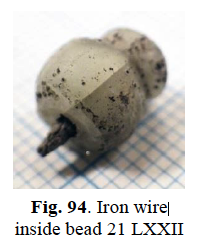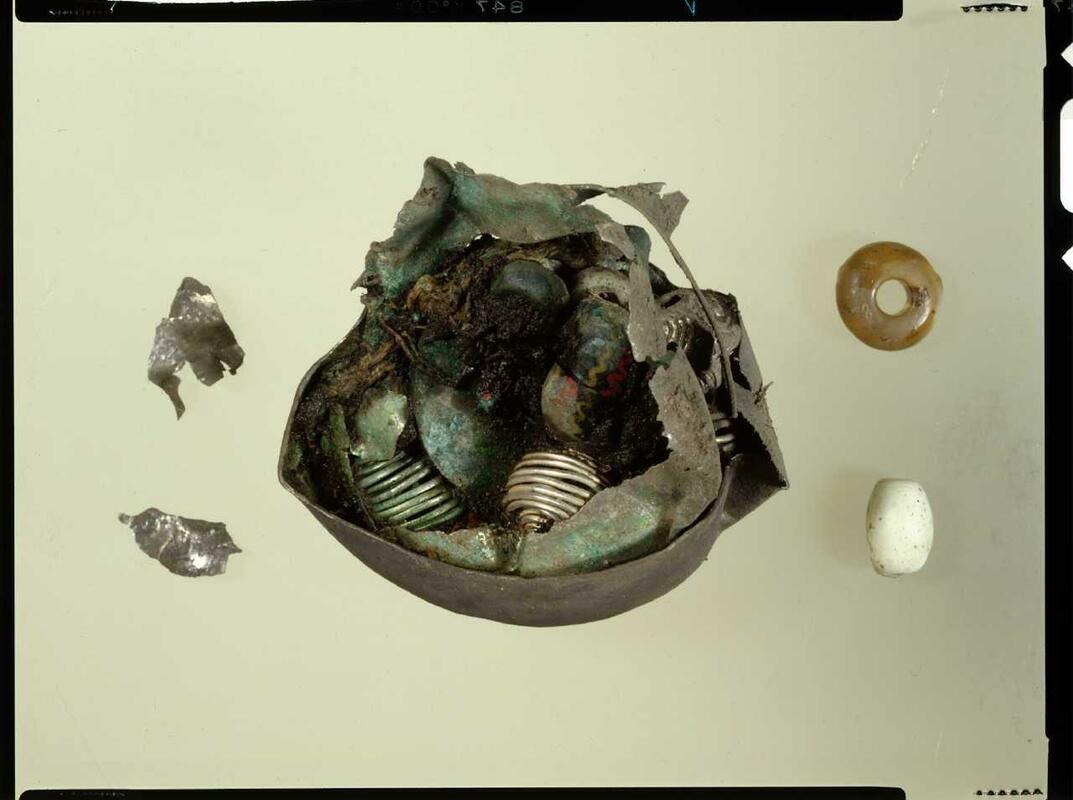 One of the beads with wire in the center from Lovö from Moa Råhlander's work.
One of the beads with wire in the center from Lovö from Moa Råhlander's work. As soon as I started researching beads, people started asking me “What did they use to string them in period?” I didn’t have an answer as I had not yet come across any evidence (though, admittedly, during the years of focusing on textiles, I would deeply read those portions and take notes, and skim through other sections of the books, making it easy to miss things).
Realistically, I think the answer should be “Whatever they had that worked,” but of course I always want further evidence to something less on the speculative side.
In the past I have tried linen string, waxed linen string, silk cord, and metal wire, as well as modern solutions (which will be mentioned more in depth below). I can honestly say that none of those more period options impressed me. All of them eventually gave out and had me scurrying to collect beads.
In her paper “How Beads come Together”, Moa Råhlander looked at burial assemblages from Townsend Farm Road in Kent (6th and 7th century), as well as Lovö in Sweden (8th and 9th century). Several beads from the latter site have traces of corroded iron wire inside of them. She states that it does not take much of a leap to come to the conclusion that it was the material used to string the beads.
Not long after having read this, David Huggins posted an image from a book about a Saxon Cemetery in Essex, England, that has well preserved bead threads that describes some as being plied pairs of threads that are plied together tightly as well as plaited techniques such as whipcord. In one of these finds the cord was wool but the rest were linen. As I was looking at the bead information last night in the book Buckland Anglo-Saxon Cemetery: Dover and I saw that it also references traces of linen cord that had been used to secure beads (this book also has lovely images of the beads that are printed TO SCALE!).
Additionally, Birka cremation grave 29 has traces of bronze wire in three of the beads and Grave 385 has it listed that melted beads were mounted on bronze wire.
ETA (3/26/19): I found images of a find from Kalmergården in Denmark that show beads with a twisted linen cord going through it (photos from the National Museum of Denmark). I am unsure of the dating beyond Iron Age, but if someone has the answer to the time for this, I would love to know it!
So now I think I have a decent answer, and it also leads to further thoughts on the matter. Wire can be fragile, especially once it gets bent or kinked. Linen cord can easily be worn through with use, though multiple plies, tight twisting, and plaiting can help maintain strength for longer. Beads can have sharp edges or even sharp bits inside the bead (especially if there was a bubble trapped against the mandrel) which will further wear at a cord. These facts add to my ideas that things like beads, especially with their high value in period, were really special occasion items. You were not working the garden in them, tending animals, or anything like that. They were reserved for better affairs. Yes, I can do all of my normal things at events while wearing my brooches an bling, including set up or tear down camp, but that does not mean that I think people did it that way in period.
Modernly, I usually use tiger tail type beading wire. I form an end into a loop and fix it with a crimp beads, string my beads and the add crimps and a loop to the other end. This has proven the most sturdy method so far (even though it is very modern). When I make my next strand of Viking beads, I am going to use tightly braided linen cord (possibly even some of my hand spun) and see how well that works. I think that if I avoid excessive labor while wearing the beads, it might be a good option. I am also planning to test out the use of braided sinew (artificial at first) as a possible option (especially given the diameter of the hole in many of the Viking Age beads).


 RSS Feed
RSS Feed